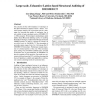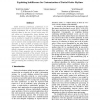972 search results - page 24 / 195 » Using Preference Order in Ontologies |
CIKM
2007
Springer
14 years 1 months ago
2007
Springer
Problems resulting from the management of shared, distributed knowledge has led to ontologies being employed as a solution, in order to effectively integrate information across a...
BMCBI
2007
13 years 7 months ago
2007
Background: Current efforts within the biomedical ontology community focus on achieving interoperability between various biomedical ontologies that cover a range of diverse domain...
KSEM
2010
Springer
13 years 5 months ago
2010
Springer
One criterion for the well-formedness of ontologies is that their hierarchical structure forms a lattice. Formal Concept Analysis (FCA) has been used as a technique for assessing ...
IDEAS
2006
IEEE
14 years 1 months ago
2006
IEEE
Unlike numerical preferences, preferences on attribute values do not show an inherent total order, but skyline computation has to rely on partial orderings explicitly stated by th...
ASPDAC
2006
ACM
14 years 1 months ago
2006
ACM
− In this paper, we present a new timing-driven placement algorithm, which attempts to minimize zigzags and crisscrosses on the timing-critical paths of a circuit. We observed th...


